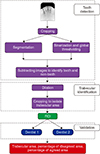1. Watanabe PC, Faria V, Camargo AJ. Multiple radiographic analysis (systemic disease): dental panoramic radiography. J Oral Health Dent Care. 2017; 1(1):007.
2. Maia AM, Karlsson L, Margulis W, Gomes AS. Evaluation of two imaging techniques: near-infrared transillumination and dental radiographs for the detection of early approximal enamel caries. Dentomaxillofac Radiol. 2011; 40(7):429–433.

3. Shivpuje BV, Sable GS. A review on digital dental radiographic images for disease identification and classification. Int J Eng Res Appl. 2016; 6(7):38–42.
4. Suprijanto , Juliastuti E, Diputra Y, Mayantasari M, Azhari . Dental panoramic image analysis on mandibular bone for osteoporosis early detection. In : Proceedings of 2013 3rd International Conference on Instrumentation Control and Automation (ICA); 2013 Aug 28–30; Ungasan, Indonesia. p. 138–143.
5. Vishnu T, Saranya K, Arunkumar R, Devi MG. Efficient and early detection of osteoporosis using trabecular region. In : Proceedings of 2015 Online International Conference on Green Engineering and Technologies (IC-GET); 2015 Nov 27; Coimbatore, India. p. 1–5.
6. Sela EI, Widyaningrum R. Osteoporosis detection using important shape-based features of the porous trabecular bone on the dental X-ray images. Int J Adv Comput Sci Appl. 2015; 6(9):247–250.

7. Jatti A, Joshi R. Image processing and parameter extraction of digital panoramic dental X-rays with ImageJ. In : Proceedings of 2016 International Conference on Computation System and Information Technology for Sustainable Solutions (CSITSS); 2016 Oct 6–8; Bangalore, India. p. 450–454.
8. Modi CK, Desai NP. A simple and novel algorithm for automatic selection of ROI for dental radiograph segmentation. In : Proceedings of 2011 24th Canadian Conference on Electrical and Computer Engineering (CCECE); 2011 May 8–11; Niagara Fall, Canada. p. 000504–000507.
9. Shah N, Bansal N, Logani A. Recent advances in imaging technologies in dentistry. World J Radiol. 2014; 6(10):794–807.

10. Raju J, Modi CK. A proposed feature extraction technique for dental X-ray images based on multiple features. In : Proceedings of 2011 International Conference on Communication Systems and Network Technologies; 2011 Jun 3–5; Katra, India. p. 545–549.
11. Tuan TM, Duc NT, Van Hai P. Dental diagnosis from X-ray images using fuzzy rule-based systems. Int J Fuzzy Syst Appl. 2017; 6(1):1–16.

12. Mani VR, Arivazhagan S. Survey of medical image registration. J Biomed Eng Technol. 2013; 1(2):8–25.
13. Dighe S, Shriram R. Preprocessing, segmentation and matching of dental radiographs used in dental biometrics. Int J Sci Appl Inf Technol. 2012; 1(2):52–56.
14. Sela EI, Sutarman . Extracting the potential features of digital panoramic radiograph images by combining radio morphometry index, texture analysis, and morphological features. J Comput Sci. 2018; 14(2):144–152.

15. Sulistyani LD, Priaminiarti M, Auerkari EI, Kusdhany LS, Latief BS. Mandibular cortex correlates to alveolar bone density in indonesian women aged 40 to 75 years. J Int Dent Med Res. 2016; 9(3):215–220.
16. Majumder MI, Harun MA. Alveolar bone changes in post-menopausal osteopenic and osteoporosis women: an original research. Int J Dent Med Spec. 2015; 2(2):9–14.

17. Lira PH, Giraldi GA, Neves LA, Feijoo RA. Dental R-ray image segmentation using texture recognition. IEEE Lat Am Trans. 2014; 12(4):694–698.

18. Sela EI, Hartati S, Harjoko A, Wardoyo R, Mudjosemedi M. Feature selection of the combination of porous trabecular with anthropometric features for osteoporosis screening. Int J Electr Comput Eng. 2015; 5(1):78–83.

19. Geraets WG, Lindh C, Verheij H. Sparseness of the trabecular pattern on dental radiographs: visual assessment compared with semi-automated measurements. Br J Radiol. 2012; 85(1016):e455–e460.

20. Amer ME, Heo MS, Brooks SL, Benavides E. Anatomical variations of trabecular bone structure in intraoral radiographs using fractal and particles count analyses. Imaging Sci Dent. 2012; 42(1):5–12.

21. Koh KJ, Park HN, Kim KA. Prediction of age-related osteoporosis using fractal analysis on panoramic radiographs. Imaging Sci Dent. 2012; 42(4):231–235.

22. Sela EI, Hartati S, Harjoko A, Wardoyo R, Munakhir MS. Segmentation on the dental periapical X-ray images for osteoporosis screening. Int J Adv Comput Sci Appl. 2013; 4(7):147–151.

23. El Allaoui A, Nasri M. Medical image segmentation by marker-controlled watershed and mathematical morphology. Int J Multimed Its Appl. 2012; 4(3):1–9.

24. Preim B, Botha C. Image analysis for medical visualization. In : Preim B, Botha C, editors. Visual computing for medicine: theory, algorithms, and application. 2nd ed. Waltham (MA): Elsevier/Morgan Kaufmann;2014. p. 111–175.
25. Elsalamony HA. Detecting distorted and benign blood cells using the Hough transform based on neural networks and decision trees. In : Deligiannidis L, Arabnia H, editors. Emerging trends in image processing, computer vision and pattern recognition. Waltham (MA): Elsevier/Morgan Kaufmann;2015. p. 457–473.








 PDF
PDF ePub
ePub Citation
Citation Print
Print











 XML Download
XML Download